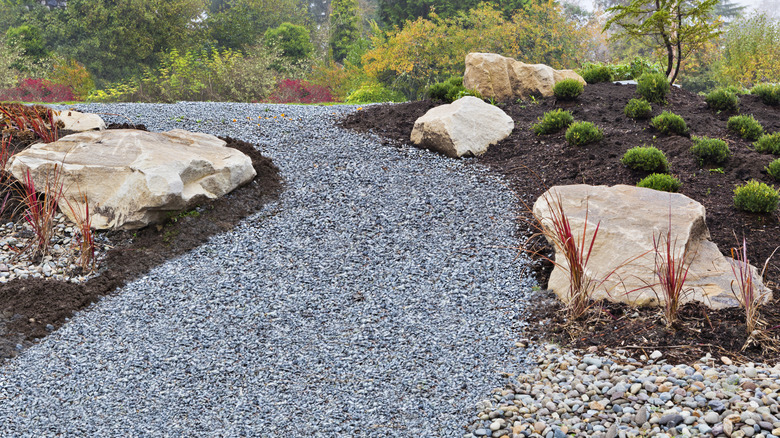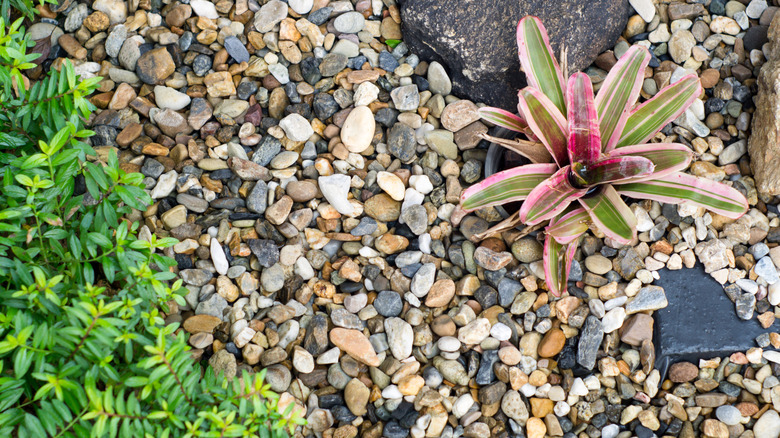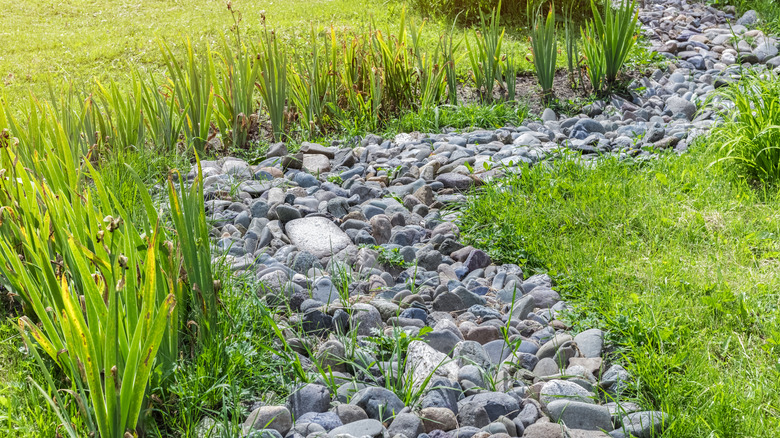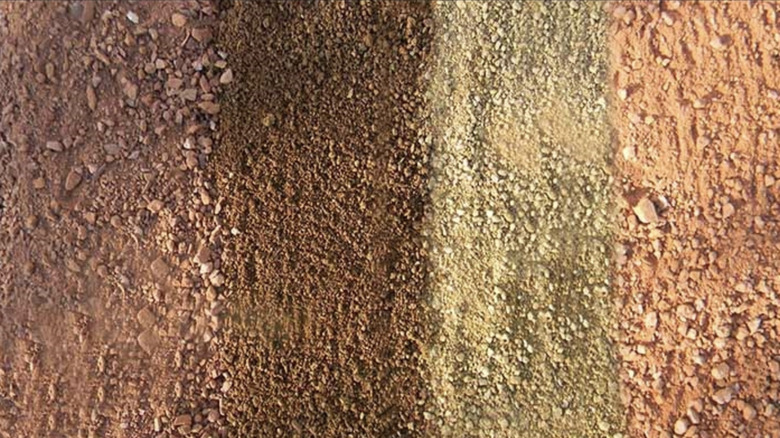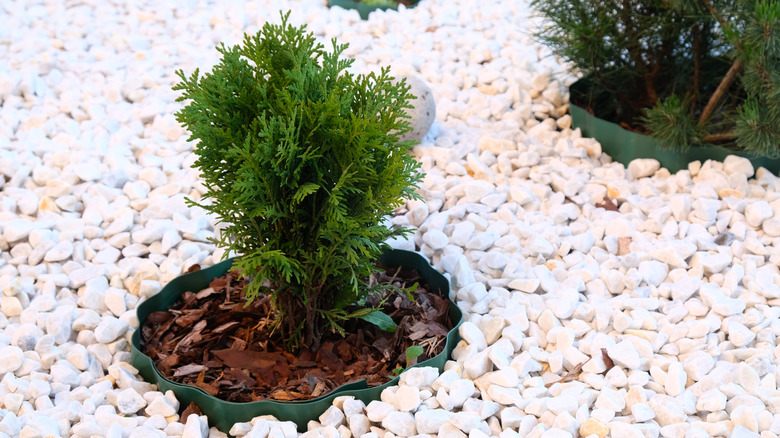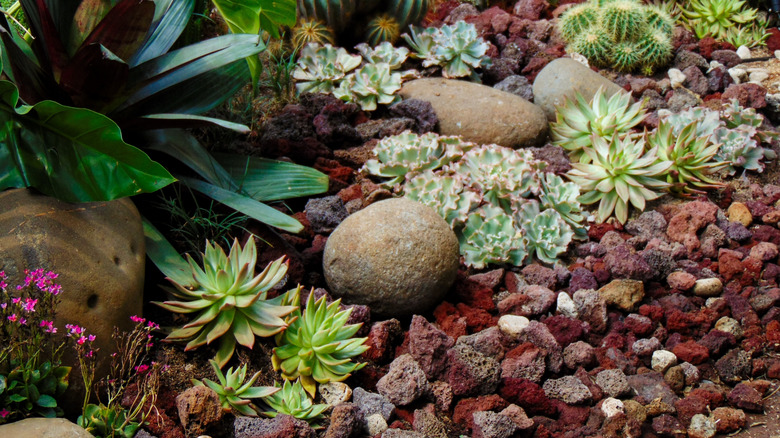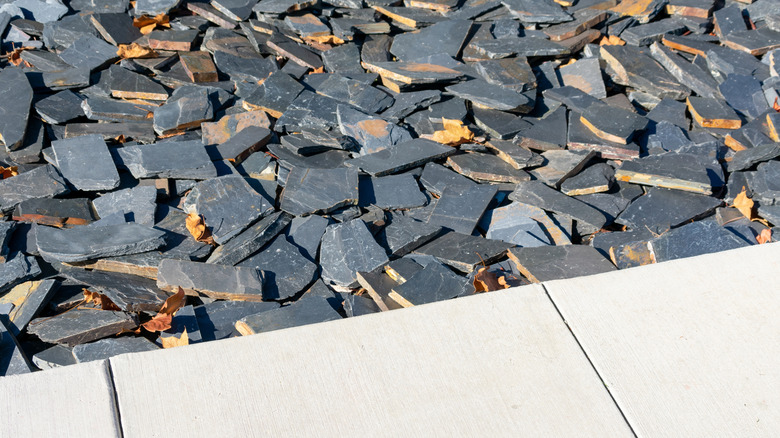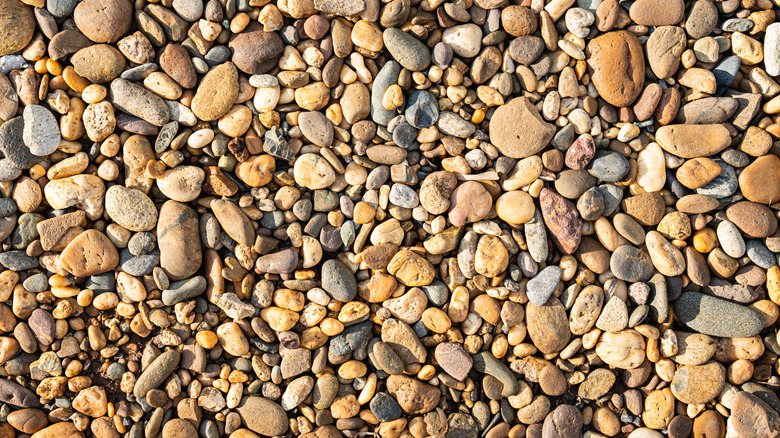7 Top Gravel Types To Consider Before Landscaping Your Yard Or Garden
Choosing the right type of gravel for landscaping is one of those very adult tasks that your younger self probably couldn't have imagined caring about. But once you have your own yard and garden to care for, you understand why it's so important to choose the right material the first time. It's pricy and labor intensive to install and remove. Not all types of gravel function well in all conditions. And then there's the aesthetics piece. White marble creates a very different look than red lava rock or gray slate. With such a wide range of colors, sizes, and shapes of stones available, there are a lot of design possibilities to ponder.
From sandy decomposed granite to polished river rocks, many gravel types are readily available through home improvement stores and local landscapers. We've rounded up some of the most popular and versatile ones that might work for your specific gardening needs. They all have pros and cons that need to be considered before making your final decision. Additionally, make sure to familiarize yourself with some common gravel landscaping mistakes that people tend to make before finalizing your plans!
Pea gravel
Pea gravel has plenty of fans, and some detractors too. It's comprised of natural stone that has been weathered over time, yielding small, rounded, pea-like pebbles. Typically pea gravel stones are between 1/8 inch and 3/8 inch in size. Pea gravel is variable in color, depending on where it's been quarried from. Stones are often shades of brown, blue, pink, and gray. It's commonly used to line walkways and driveways, though some people also use it in place of mulch around plants. Pea gravel allows for good drainage, so water should flow through the stones rather than puddle on top. It's also one of the more affordable options for landscaping gravel.
It isn't right for every yard, though. Pea gravel has quite a few downsides that you should know about before placing an order. The biggest complaint people tend to share is that it doesn't stay put. The small stones are lightweight enough that they blow around in the wind, get thrown around by your lawnmower, shift when people or animals walk over them, etc. Weeding can also be difficult in areas covered with pea gravel. And the pebbles, despite being smooth, aren't ideal for walking on. They're small enough that you might feel a stabbing sensation if you walk over them barefoot. Keep that in mind if you have kids or dogs who might play in the area where you're laying down gravel.
River rock
River rock has a lot of advantages as a landscaping material. Aesthetically, it might remind you of a zen garden retreat or a tranquil lakeshore. As the name suggests, river rock is comprised of stones pulled from riverbeds and other water sources. The stones are smooth and rounded from years of exposure to water and weather. They're available in a range of sizes, from small pebbles to rocks the size of your palm (and even larger). River rock is a natural choice for landscaping around water features, though it may also be used for things like lining pathways and edging garden beds.
As for pros and cons? River rock stones are larger than pea gravel, therefore they tend to stay in place even in windy weather or if you're using a leaf blower in the area, which makes it more low-maintenance than some other gravel types. It's comparable in price to pea gravel and there are a variety of color options available. Home improvement retailers sell river rock in bags of mixed colors, but you could also buy exclusively gray or black or brown rock if you wish. As for the cons, one important downside to consider is weeding. It's essential that you place a weed barrier under the rock, and even so, they may start to grow through river rock over time. That being said, weeding can be a challenge with other types of gravel landscaping, too, but luckily there are simple solutions for removing them.
Decomposed granite
Decomposed granite (commonly referred to as DG) is a much finer material than pea gravel or river rock. It's made from granite that has been crushed and weathered to the point that it resembles coarse sand. DG is roughly comparable in price to pea gravel and river rock, and is also available in a range of shades. In addition to the standard grays and browns, you can buy DG that's gold, green, or even a rosy shade of pink.
Like sand, decomposed granite compacts well, especially when it's wet. That property makes it a useful material for creating many things, and is great for hardscaping projects, including pathways and driveways. There's a careful process that must be followed when building a stable DG surface like a walkway or patio. The material needs to be put down in thin layers, wetted down, and pressed using a plate compactor. That process is repeated several times to create a surface that's hard enough to walk on without disturbing it. DG can also be used as a cost-effective landscaping material for around garden beds and under trees.
Marble chips
If you choose marble chips for your landscaping purposes, it's probably not going to be for purely practical reasons. That's not to say that marble chips aren't perfectly safe and functional as landscaping material; they can be. It's just that using the bright white or silvery rock in your landscaping is so distinctive that it reads as a design statement. (This material is also available in shades of gray.) Is using marble chip gravel for your driveway worth it? If you're trying to create Mediterranean vibes in your space, white marble is definitely a gravel option you'll want to consider.
Cost may be a drawback, however. Marble chips are on the high end of the price spectrum for gravel. They require some regular maintenance to keep them looking great. Any stray leaves, "helicopters" dropped from maple trees, weeds, and other detritus will be very noticeable against the light colored marble. But, stability is a perk. Marble chips are often sold in sizes ranging from 1/2 to 3 inches, which should be heavy enough to stay put no matter the weather. You shouldn't have to replenish marble as often as you might need to with pea gravel, DG, and other lightweight gravel.
Lava rock
Lava rock is pretty distinctive. It's available in some shades of gray, but it's the black and rich burgundy hues that lava rock is really associated with. Deep red lava rock is particularly striking when it's contrasted with bright green plant life, or other bright colors in your yard. The rough, crated texture also makes lava rock easy to distinguish from other types of stones. And there's just something cool about knowing you have real pieces of volcanic lava in your backyard.
Lava rock is formed when hot magma cools quickly. Gases escape from the rock as it cools, creating tons of tiny holes. That makes lava rock quite porous and more lightweight than many other types of rock. You can use it in dry creek beds, around water features, near gutter downspouts, and in other areas where good drainage is important. But lava rock isn't a good choice for pathways or anywhere that people or pets might need to walk. It's the landscaping equivalent of LEGOs; great to look at, but really painful to step on.
Slate gravel
Slate chips can be a good multipurpose choice for landscaping, especially because they're available in a variety of sizes. You could use larger chips (1 inch or larger) to create a pathway. Smaller slate chips can be used decoratively in a rock garden, around water features, in potted plants, to edge flower beds, and so on — they do a great job keeping soil cool and moist. Slate chips should be relatively flat and therefore more comfortable to walk over than other gravel options. They are also super durable.
As for aesthetics? The dark gray tones that are typical of slate are a nice contrast to bright greens and other colors of your garden. And, as we mentioned, slate can help your soil retain water, so it may be especially useful in dry climates. There are a few potential drawbacks to using slate chips for landscaping. One is availability. Your local home improvement store may not sell slate chips, or not sell them in multiple sizes. Check with local landscaping suppliers instead. Slate chips also tend to be slightly pricier than river rocks or DG, though cheaper than marble chips.
Jersey shore gravel
Even if someone has never heard the term Jersey shore gravel, they could probably guess what it looks like — if they've been to the Jersey shore, at least. Comprised of small rounded pebbles in shades of white, yellow, tan, and brown, this gravel looks like sand. It's a staple in New Jersey yards, because this particular kind of stone is a remnant of the Appalachian Mountains and is dredged from mines in the state. It can be used like pea gravel or other small stone gravel: for pathways, in garden beds, patios, etc. The pebbles are generally rounded enough that they should be fairly comfortable for most people to walk on.
This kind of gravel reads as beachy, so it could be a great choice if you're trying to DIY a light and sunny oasis in your yard. But you don't have to source pebbles directly from New Jersey to use this kind of gravel in your yard. Check with your local gravel supplier for products called "polished yellow pebbles" or "yellow beach stone" to get the Jersey shore gravel look. It's not available through as many retailers as more common gravel options are. Price-wise, this material tends to be comparable to pea gravel and lava rock.
